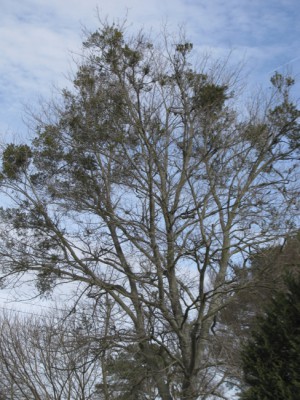Mistletoe on your mantle makes a lovely holiday decoration, but the mistletoe in your tree is a parasite. Your landscape trees will be healthier without it. Prevent mistletoe infestations by inspecting and pruning your trees as necessary.
What’s The Problem?

Red maple infested with mistletoe
Mistletoe has root-like structures that invade twigs and stems, sapping moisture and nutrients from your tree to support its own growth and reproduction. This parasitic plant does produce a portion of its own food (via photosynthesis), so technically we define it as a hemiparasite.
Among our urban trees in Hampton Roads, red maples and silver maples seem to suffer the worst mistletoe infestations, although Phoradendron serotinum (our dominant local species of mistletoe) is known to thrive in over one hundred different species. Although a healthy tree and mistletoe can coexist, if the mistletoe spreads throughout the crown, your tree may become severely stressed. Urban landscape trees are often already stressed by abnormal growing conditions not present in a natural forest. The additional stress of mistletoe infestations can contribute to the decline and death of valuable landscape trees.
Mistletoe produces white berry-like fruits containing a sticky seed that many local birds will eagerly eat. Often enough, the living seed will pass through a bird’s digestive tract and settle on a tree branch where the seed will germinate and attempt to invade the tree. Large or tall host trees used by birds as a favorite perch are particularly susceptible to heavy infestations.
Removing Mistletoe Infestations
If important trees in your landscape are suffering from mistletoe infestations, we believe it is best to remove the offending parasite. Removal will reduce damage and prevent further spread. One of our ISA Certified Arborists can evaluate your trees and provide proper advice and control methods.
If your tree has a minimal amount of mistletoe, the usual control method is to prune the infected branches approximately twelve inches below the site of the infection. If a structurally or aesthetically important branch is infected, we may recommend removing only the parasite’s foliage. We usually do not recommend chemical treatment because of the risk of injuring the tree and the need for repeated applications. In my experience, chemical treatment does not produce improved results because it only kills the parasite’s foliage and not the root-like structures.
Any pruning to remove mistletoe infestations from your trees should follow industry guidelines contained in the ANSI A300 Standards for Tree Care Operations. Improper pruning methods such as topping should be avoided.
Take a look at your trees. If you see a problem with mistletoe, give us a call or send me an email. We’ll remove any mistletoe infestations from your trees and if you hire us in early December, we can leave you some greenery for holiday decorations.
